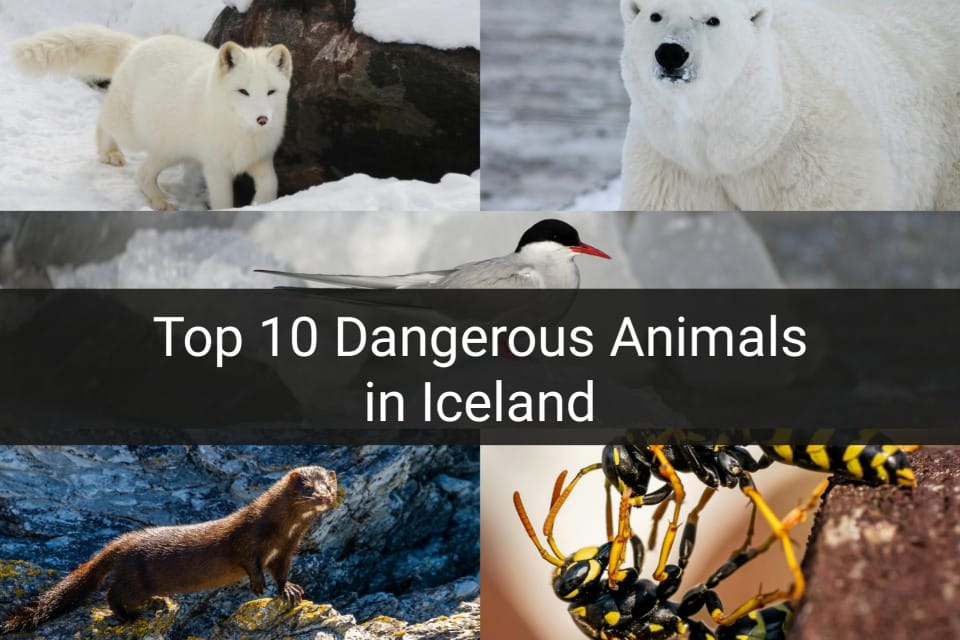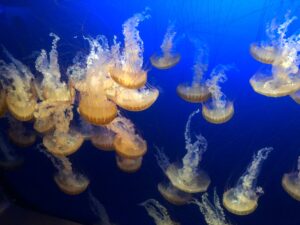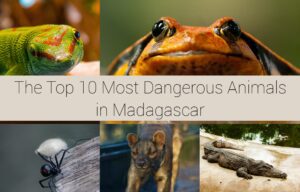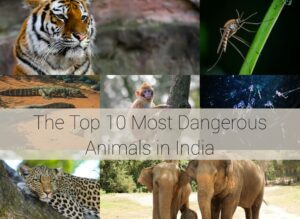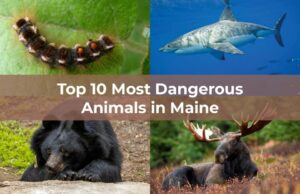Iceland is one of the few places that has no snakes, scorpions, or poisonous spiders. This means there are no dangerous animals in Iceland, right? Wrong, Iceland has some animals that can be dangerous.
In this article, we will cover the Top 10 most dangerous animals in Iceland.
The Top 10 Dangerous Animals in Iceland
1. Arctic Fox

Scientific Name: Vulpes lagopus
Arctic foxes are the only native mammals found in Iceland. These animals look cute and fluffy, and their looks can be deceiving.
They are the most dangerous animal in Iceland, and they are known to carry diseases that are deadly to humans.
One such disease is the Arctic rabies virus. This is transmitted through bites to humans and can be fatal.
Arctic foxes are shy animals, and they will mostly avoid human contact. Remember to keep your distance if you spot one in the wild.
In Iceland, Arctic foxes are found in every region, but they are sure to be sighted in the Westfjords region. This is due to the presence of bird cliffs, where they hunt for food.
Since they are carnivores, their diet mostly consists of small animals such as lemmings, voles, ringed seal pups, fish, waterfowl, and seabirds.
2. Polar Bear

Scientific Name: Ursus maritimus
Polar bears are not native to Iceland, but they occasionally drift over on ice floes from Greenland.
Polar bears possess the same physical traits as other bear species. These massive predators are powerful hunters with no natural predators.
Since it is common to find polar bears hanging around areas with high seal populations, the Jökulsárlón Glacier Lagoon is a popular spot for these bears in Iceland.
They can be extremely aggressive when they are hungry or feel threatened. If you are in a situation where you are faced with these massive creatures, do not make sudden movements and do not run. If the polar bear tries to attack, try as much as possible to make yourself look big and act like a threat.
3. Arctic Tern

Scientific Name: Sterna paradisaea
Arctic terns are small birds that are known to fly more than 45,000 miles from the Arctic Circle to the Antarctic Circle every year.
This bird can be very protective of their young and nest, and they won’t hesitate to attack you with their sharp beaks when you get close.
Arctic terns are iconic for striking the top or back of the heads of humans and other large predators.
Their behaviour can be classified as more of a nuisance than a danger. Arctic terns nest all around the coast of Iceland.
Remain cautious when you come across these birds, and do not try to go close to their nests, especially during the breeding season, from May to July.
4. Mink

Scientific Name: Neogale vison
Another dangerous animal that can be found in Iceland is the mink. They are semiaquatic mammals that are found near rivers and lakes.
Minks can be aggressive when they feel threatened or cornered. They can inflict very painful and deep wounds. These bites and scratches can transmit pathogens and lead to serious health issues.
These little mammals are mainly nocturnal. Although they are active at night, they occasionally move around during the day.
I will classify minks as being more aggressive than they are social. So if you spot these animals in Iceland, always watch from a distance.
5. Wasps

Scientific Name: Vespidae
Wasps are another species that fall under this category. They are known to sting repeatedly, and this can become dangerous when they do this in large numbers.
In Iceland, wasp attacks are rare, but they are most active in late summer and early autumn. Wasp attacks happen when their home is disrupted, so be cautious when moving outdoors or near trash bins.
Aside from being painful, wasp stings contain toxins that can cause allergic reactions in some people.
6. Seals

Scientific Name: Pinnipedia
Seals are semi-aquatic animals that are found along the coastlines of Iceland. These marine mammals tend to be naturally cautious of humans.
They can be aggressive when they feel threatened or are protecting their young. Seals can bite or scratch humans, and this can lead to serious infection or illness.
The best place for seal watching in Iceland is the Vatnsnes Peninsula, which is located in northern Iceland.
7. Jellyfish

Scientific Name: Cyanea capillata
If you are planning on going swimming in Iceland, then you should be worried about jellyfish. The most common jellyfish species in Iceland is the lion’s mane jellyfish.
The lion’s mane jellyfish has long tentacles that contain nematocysts that can deliver a painful sting. Although their venom is not as life-threatening as that of box jellyfish, they can cause skin irritation, rashes, and, in rare cases, allergic reactions.
If you spot a jellyfish washed ashore or while swimming in the water, do not make contact with its tentacles.
8. Killer Whales (Orcas)

Scientific Name: Orcinus orca
Killer whales, also known as orcas, are the largest member of the oceanic dolphin family. These apex predators are rarely aggressive towards humans in the wild.
Their large size and advantage in the water make them very formidable if they choose to attack.
In Iceland, orcas are regularly seen around coastal waters, especially in the Snæfellsnes Peninsula and around West Iceland. It is normal to sight orcas I’m the waters while kayaking or boating.
9. Great Skuas

Scientific Name: Stercorarius skua
Great Skuas are large seabirds that are found in Iceland. This bird is known for being aggressive, especially during the breeding season.
A Great Skua Will not hesitate to dive-bomb intruders found close to their nests, usually located in coastal areas and on islands.
In Iceland, Great Skuas are known as Skumur, and they are particularly found in the Westfjords, the Reykjanes Peninsula, and other northern regions of the country.
10. Puffins

Genus: Fratercula
The last animal on this list is Puffin. They can be identified by their black or black and white feathers and brightly coloured large beaks.
Puffins are one of the most iconic animals found in Iceland. These small seabirds are not considered dangerous, but due to their wild nature, they might peck at you with their sharp beaks.
Puffin colonies are found on cliffs and islands around Iceland. The best time to see them is from May to August.
Some of the popular puffin-watching spots in Iceland include the Westman Islands (Vestmannaeyjar), the Látrabjarg cliffs in the Westfjords, and Dyrhólaey near the south coast.
Conclusion
Iceland is known as the land of ice and fire, and rightly so because of the stunning landscapes that include active volcanoes. The Nordic island country is considered a safe destination for travellers.
Iceland does not have any poisonous or venomous snakes, spiders, or scorpions, but some animals can still pose a threat.
In this article, we have provided a list of the top 10 dangerous animals in Iceland and why they are considered harmful.
In summary, the top 10 dangerous animals in Iceland are attic foxes, polar bears, arctic terns, minks, wasps, jellyfish, orcas, Great Skuas, seals, and puffins.
FAQs
What are the most dangerous animals in Iceland?
The most dangerous animals in Iceland are attic foxes and polar bears. These animals can be intimidating to humans and cause serious injury.
Are there any venomous snakes in Iceland?
No, there are no venomous snakes in Iceland. The climate in the country makes it impossible for reptiles to survive.
Are there wolves in Iceland?
Wolves cannot be found throughout Iceland. The only closely related animal to wolves in Iceland are attic foxes.
Are there any dangerous insects in Iceland?
While Iceland does have wasps, there are no other dangerous insects. Mosquitoes and other pests are rare due to the cold climate.

Hi, I’m Louis Ojibe, and I grew up around wildlife in Africa. I have always been fascinated by animals and nature across the world.
As a child, my parents used to take me to see wild animals like lions, elephants, gorillas, tortoises, and many others at our local zoo.

